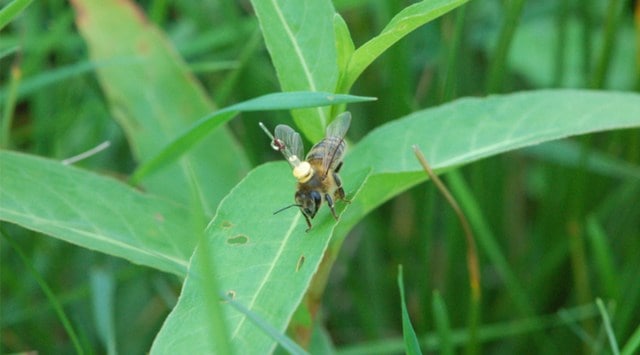- India
- International
Bees follow roads & water channels to navigate home just like pilots before avionics: Study
Scientists have shown that honeybees use "linear landscape elements," like water channels, roads and the edges of fields, to navigate and find their way back home.
 The researchers fitted tiny transponders on 50 bees to track and analyse their flying patterns. (Image credit: Frontiers)
The researchers fitted tiny transponders on 50 bees to track and analyse their flying patterns. (Image credit: Frontiers)
Before cockpits were filled with instrument clusters, pilots used lighthouses, roads, and other landmarks as navigation aids in a method known as contact flying. Now, researchers have shown that bees find their way home by “orienting themselves” in relation to dominant linear landscape elements, just like those early pilots.
According to the journal Frontiers, a century of research in “bee science” has shown that honeybees are excellent navigators who can use their sense of smell, the sun, the sky’s pattern of polarised light and possibly, the Earth’s magnetic field. They are also excellent learners, making them able to recognise different memories to create general rules.
Now, in research published in Frontiers’ Behavioural Neuroscience journal, scientists have proven that honeybees find their way home by using linear landscape elements like rivers, roads, edges of fields and other linear elements to navigate home.
“Here we show that honeybees use a ‘navigation memory’, a kind of mental map of the area that they know, to guide their search flights when they look for their hive starting in a new, unexplored area. Linear landscape elements, such as water channels, roads, and field edges, appear to be important components of this navigation memory,” said Randolf Menzel, lead author of the study, in a press statement. Menzel is an emeritus professor at the Department of Neurobiology of the Free University of Berlin.
Using tiny transponders to track the bees
In 2010 and 2011, the research group caught 50 “experienced” forager honeybees in the village of Klein Luben in Germany. They then glued a transponder weighing around 10.5 milligrams to their backs before releasing them in a new test area that was too distant to be familiar to the bees.

This test area had a radar, which could detect these transponders up to a distance of 900 metres. It also had a notable landmark–a pair of irrigation channels running southwest to northeast.
When honeybees find themselves in unfamiliar areas, they fly around in different directions and over different distances in “exploratory loops.” Using the radar, the researchers tracked the exact exploratory flight patterns of each bee for between 20 minutes and three hours.
Non-random search patterns and flight memory
To see if these exploratory flights were random, the researchers first simulated two sets of random flight patterns. Since the observed flight patterns were very different from these, they concluded that honeybees were not conducting random exploratory flights.
To explore the honeybees’ flying patterns further, the researchers used advanced statistics to analyse the orientation of lights and the frequency of their flying over each 100 by 100 metre block within the test area. This analysis showed that the bees spent a disproportionate amount of time flying alongside irrigation channels.
They also found that these channels continued to guide the honeybees’ flights even when they were more than 30 metres away, which is the maximum distance that they can see such landscape elements. This fact implied that the bees kept these channels in their memory for long periods of time.
“Flying animals identify such extended ground structures in a map-like aerial view making them highly attractive as guiding structures. It is thus not surprising that both bats and birds use linear landmarks for navigation. Based on the data reported here we conclude that elongated ground structures are also salient components of the honeybees’ navigation memory,” wrote the authors in the study.
More Tech
Must Read
Apr 23: Latest News
- 01
- 02
- 03
- 04
- 05







































